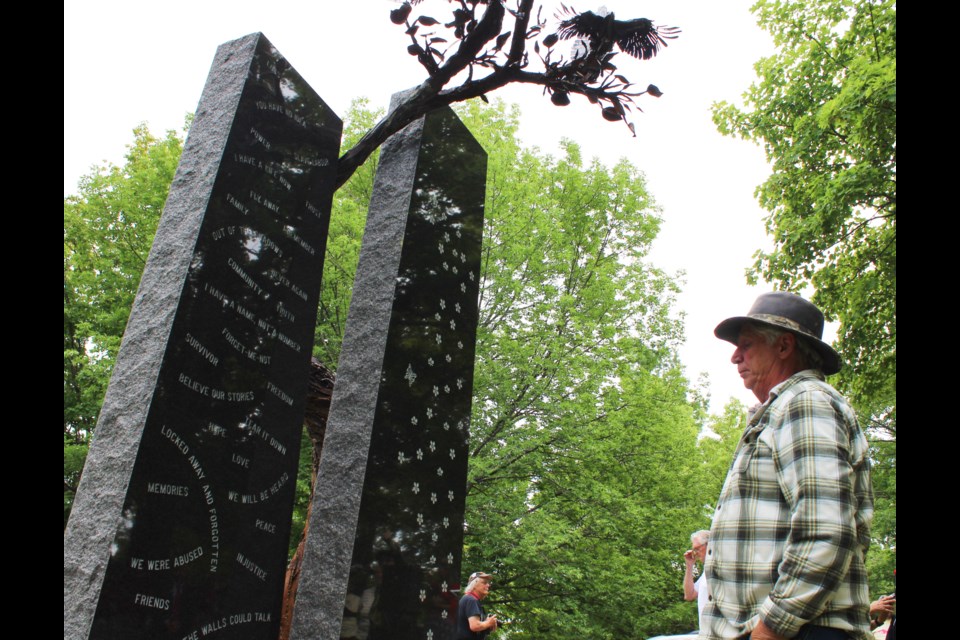A monument unveiled Saturday at the Huronia Regional Centre (HRC) Cemetery is a way for people to remember both those who survived and those who died at the Orillia institution.
However, Carrieanne Ford-Tompkins would sooner forget.
“It releases my soul,” she said of the Survivors Memorial Monument, "but when I see the HRC, it brings back the trauma.”
She wouldn't even glance across the street at the buildings in which she used to reside.
Ford-Tompkins went into the HRC when she was 13 and stayed there until she was 28. During that time, she said she experienced physical, sexual and emotional abuse.
She has post-traumatic stress disorder and and still loses sleep at night. When she does drift off, the nightmares await.
“It’s like a broken record,” said the Brampton woman. “I would like to end this horrible tragedy of the past, but it’s not easy.”
Brian Logie knows the feeling, having spent six years at the HRC. He spoke to the crowd Saturday.
“I’m Brian Logie. I’m a survivor,” he began.
However, he had no interest in speaking about himself.
“I want to talk about the people who are not here. It breaks my heart,” he said. “I hope we never forget.”
Lynda Lou Gourlie couldn’t forget the HRC if she tried. Her sister, Diane Marilyn Gourlie, was four years old when she entered the institution for the developmentally disabled in 1958. She remained there until almost 1970.
“I remember the metal doors clinking. It was like a prison. We couldn’t go past that point,” Lynda Lou Gourlie said of the times her family would drop her sister off.
“When she got out, she was so severely institutionalized, they put her in a psych ward and they couldn’t control her," Gourlie added.
The experience took its toll on the family members who visited once a month and had to say a painful goodbye over and over again.
“We were always in agony that we had to give her away all the time,” Gourlie said. “We were victims of the atrocities and abuse, too. The pain that our family went through was excruciating.”
Her sister is now 64 years old and living a better life in a group home in North York.
“After years of therapeutic help, she’s functioning with other adults,” Gourlie said.
During the ceremony Saturday, Mitchell Wilson provided a brief history of the HRC. He has been researching it to help Remember Every Name, a group that is working to identify and mark gravesites at the cemetery.
The first buildings at the stand-alone HRC site on Memorial Avenue opened in 1889, and the institution “operated as the heart of the eugenics movement in Ontario” over the next few decades, Wilson explained.
The number of people buried at the cemetery remains a mystery, with estimates being anywhere from 1,500 to more than 2,000.
The causes of death varied. Disease was a major one in the “grossly overcrowded facility,” which, despite being designed for 1,400, housed almost 3,000 people at its peak.
“They were basically left to live in their own filth, and that led to a huge mortality rate,” Wilson said.
Some were hit by trains that used to run near the property. Some died of asphyxiation after being left alone in steam rooms. Others were beaten to death.
“Most of these deaths were never investigated properly,” Wilson said, noting more than 4,000 people died during the first 100 years the HRC was in operation.
Some say the treatment of residents improved in the facility’s later years, before it was shut down in 2009, but Wilson read an abuse report from the early 2000s that included details of a staff member brandishing scissors and threatening to cut off residents’ genitals.
“That doesn’t sound like a place I’d want to live,” he said, to which survivors in the crowd yelled, “Nope,” in agreement.
There were cheers and tears when the monument was unveiled.
“Finally, it’s a reality. It’s finally arrived,” said Hilary Clark Cole, the Gravenhurst artist who created the monument with the help of Steve Sanderson, owner of Signature Memorials in Orillia.
“I hope you all enjoy this sculpture. I think some of the most important moments you’ll have are by yourself when you’re with this sculpture."
Simcoe North MPP Jill Dunlop and Parry Sound-Muskoka MPP Norm Miller helped survivors and their supporters navigate the red tape and receive government approval to erect the monument, which was funded by unclaimed money from a class-action lawsuit survivors launched against the province.
“To help bring closure to the survivors and families is very important to me,” Dunlop said, describing the sculpture as “a symbol of your strength and resilience for the atrocities you have faced.”
Miller said the monument was “long overdue.”
It acknowledges the residents’ negative experiences, he said, but added it “simultaneously celebrates all that the survivors have overcome and their successes since leaving the centre.”
Mayor Steve Clarke thanked everyone who was behind the “amazing” sculpture.
“The HRC is such a significant part of Orillia’s past, and not all of it is wonderful memories,” he said. “This particular piece will allow us to celebrate the residents who were in the HRC … and the former residents who are in our community.”



